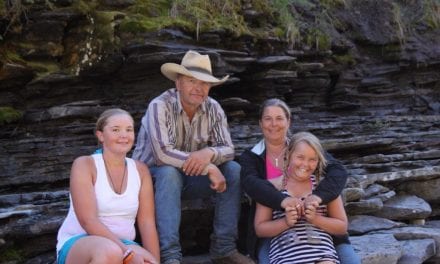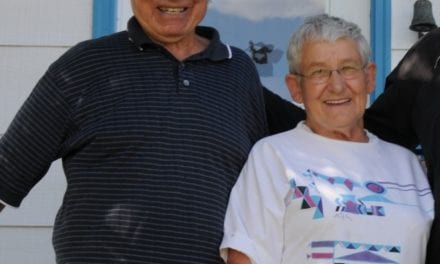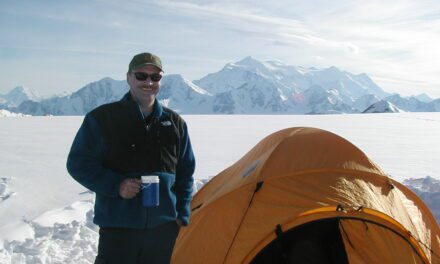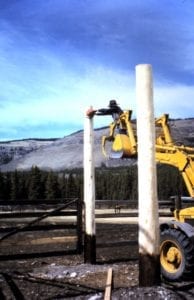
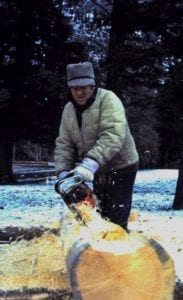
John Cutting the gate posts at the Ya Ha Tinda Ranch and prepping a log for Palliser Cabin.
Photos courtesy of Don Mickle.
When you were in town did you work for the Town of Banff?
(00:09:20) Marie – Yes, I worked for the Town of Banff and prior to that I worked for the Banff School District. When we lived at Lake Louise, I worked part-time at the RCMP detachment. That was just a seasonal kind of thing. Then, after we moved to Banff, I worked for the Banff School Board and later, when the town became incorporated, I went on the municipal side of things and worked in Corporate Services for the town. So collectively I worked 14 years with the two. When I worked for the school board it was on the municipal end of things, like I worked for the FCSS (Family and Community Support Services).That was considered a municipal function, as opposed to education.
In retirement, do you still ride horses?
(0:10:25) John – A little bit. I’ve got a couple of colts to start if we are healthy enough to do it.
Marie – We will be (healthy enough).
Your Mom is now in Banff?
(0:10:37) Marie – Yes, she’s in St. Martha’s place. She’s been there just over a year now, coming up to a year now, the end of April. It’s ironic that I am no longer in Banff, but she is! These little twists that people’s lives take.
Do your write?
(0:11:14) Marie – Yes, I do my own little stories and family history. I wrote that poem after Johnny and Larry had that bear incident. It (the bear incident) was pretty intense I think!
What were some of your duties as Barn Boss?
(0:11:58) John – I would look after the horses and the buffalo when I first went there. I did most of the trucking, bringing the horses in from the ranch to the parks. To start with, I used to truck in 70 head to Banff, Lake Louise and Kootenay. I’d get the horse shoers in to shoe all the horses and as they were done, they would take them out to the different parks. I had to do all the buying of the hay and the oats and all that stuff. I repaired the equipment (including tents for the spike camps). That was the hard part, the tents. Sewing and patching those, all the holes and the rips. They used to have a tent camp somewhere. I don’t remember where, but I remember patching some of their tents…They had a sewing machine in what they called the leather room, downstairs in the basement of the warden office. In later years they put that building over by the barn. That was good. That was a lot better there than down in the basement because there was no sunlight (or ventilation downstairs). And I eventually had to wear glasses down there eh. I think that is what ruined my eyes.
Did you have to do much with the buffalo?
(0:14:04) John – We got rid of the offspring every other year. So we had to get them in and get them tested and then find someone who would want them.
Was that hard, finding people to take buffalo?
No, not really. Most of the time, they went down east. But they had to be tested for Brucellosis before they could leave the province. The last buffalo went to Fort McMurray. Larry Gilmar and I took them up there. We trucked them up. I think it was six head. That was in the 1990s, just after I got out of the hospital and went to the ranch.
What was your surgery?
A triple bypass. I’ve been patched a few times!
Were your duties similar at the ranch?
(0:15:30) John – In 1996 (John and Marie went to the Ya Ha Tinda ranch). I was the Manager.
(0:15:44) Marie – The brood herd was a big part of John’s responsibility there. The brood herd was the heart and soul of the ranch. The broodmares were mostly quarter horses. Johnny and I started to register the offspring from the quarter horse mares with the American Quarter Horse Association. We chose the prefix “Ya Ha Tinda” for their names, so all of the registered foals were named alphabetically according to their year of birth but had the prefix “Ya Ha Tinda”. For instance, the gelding that Johnny bought when he left the ranch is named “Ya Ha Tinda Luke”. We felt a lot of pride in raising these horses and being part of their lives from the time they were born to the time they were assigned to a National Park. And we were glad that we were not at the ranch when management dumped the brood herd. There are many advantages to raising the patrol horses at the Ya Ha Tinda as opposed to buying them from unknown sources. During this liquidation process, we purchased one of the brood mares from Parks Canada and raised 2 foals.
(0:15:46) John – Yeah, I also had to look after buying the hay and all that.
(0:15:54) Marie – The generators were a huge responsibility as they provided power for the ranch buildings. (Because of its remote location, the ranch is powered by generators.) Everyday he had to check those and make sure that they were running.
(0:16:00) John – There were two fellows there who were horse breakers. These two trainers did a great job on training these colts. We had to make sure that we got the colts broke. Then we looked after the land too. Like keeping the brush down, cutting brush. It was ranch life, just like how you would run your own ranch.
(0:16:25) Marie – Then there was a campground there. A lot of people would get hurt. So you would be the one calling dispatch saying “We have a broken leg or we have a broken back. We need assistance.” Then STARS (helicopters) started coming in. One summer we had STARS three or four times straight. In quick succession for various horrible accidents, usually horse related. We met with Tim Auger and Marc Ledwidge (public safety wardens) to come up with a sort of protocol on who to call on incidents at the Ya Ha Tinda as some involved mountainous terrain where STARS would or could not go.
(0:16:45) John – And the generators, running the lights, they run all the time, day and night. I had to look after them and keep them running. Lots of times in the middle of the night, the power would go off. So you would have to get up and go and see what was wrong.
(0:17:09) Marie – And then there was always the people who would try to go through on quads, you know off road vehicles and wagons. They would monitor that. Chase them down and try to get license plates. And there were poaching incidents, that sort of thing. Fish and Wildlife would be the appropriate authority there. That was always interesting in hunting season, wasn’t it?
(0:17:37) John – Everyday was interesting because there was always an animal, wolves or bears or something. We never did see a cougar. Oh, yeah A.L. Horton and I did. Just the one. But we had bears go through the yard, grizzlies.
Were there any issues with bears and the horses?
No. In the spring, two years in a row, two bears would come to the oats and scare the horses. So I had to quit feeding oats.
Were you out there at the ranch by yourselves?
(0:18:25) John – There was always another guy there. There were three of us.
(0:18:29) Marie – We would rotate the days off. There were usually at least two employees there. That’s what you would aim for, except holidays and stuff. Like during the Dogrib Fire (2001) we were there by ourselves. It was very interesting. I don’t recall ever being scared, but certainly concerned, especially for park wardens Elaine and Dave who were coming through (Park warden friends who were riding from the Barrier cabin to the ranch).
Don your days off, did you always have your place I Sundre?
(0:19:09) John – We had our place in Water Valley. We had a quarter section west of Water Valley where we built a log cabin and a log barn.
(0:19:15) Marie – So we would go there or sometimes into Banff and see the kids. But usually we went to the cabin. We worked five days and then had two days off. Other guys worked ten and four because they had farther to travel on days off and 4 days was better for them. Like Rob would have to come to Banff. The other fellow was from up around Rocky. We just went to the cabin and we really liked it there so it wasn’t like it was a hardship to have just two days off.
(0:20:06) John – With the ranch I had to look after it. I always thought that I had to be there. I liked it so much there.
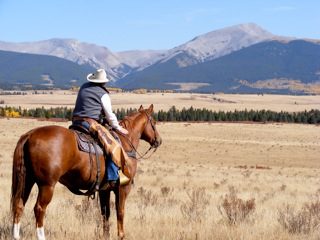
John looking at the view from the Ya Ha Tinda
Photo by Marie Nylund
